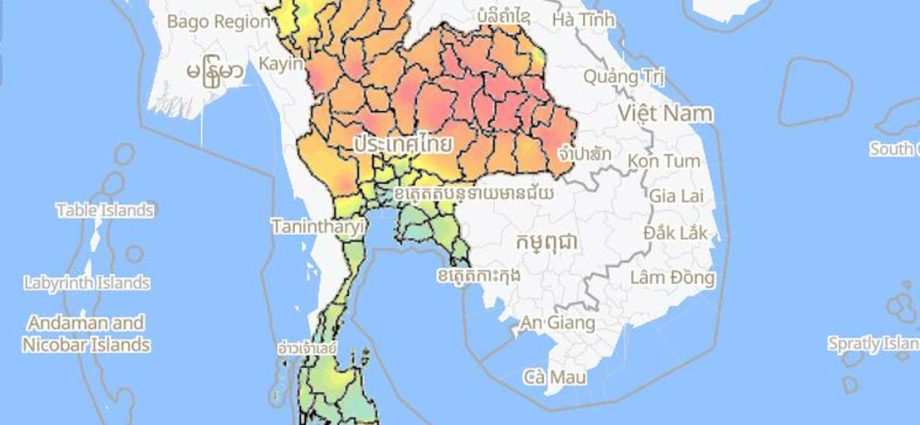
Forty-eight from all 77 provinces, especially those in the Northeast, experienced hazardous levels of ultrafine dust on Thursday morning, according to the Geo-Informatics and Space Technology Development Agency (Gistda).
Gistda reported at 10am that 13 provinces were blanketed by red (seriously harmful) levels of particulate matter 2.5 micrometres and less in diameter (PM2.5), ranging from 75.8 to 97.7 microgrammes per cubic metre (µg/m³) of air over the past 24 hours. The government’s safe threshold for PM2.5 is 37.5 µg/m³, while the World Health Organization (WHO) guidelines recommend 25 µg/m³.
In descending order, the affected provinces included Roi Et, Kalasin, Maha Sarakham, Nong Bua Lam Phu, Mukdahan, Khon Kaen, Yasothon, Chaiyaphum, Udon Thani, Chai Nat, Phetchabun, Amnat Charoen and Ubon Ratchathani, with the majority located in the Northeast.
Orange (initially unsafe) levels of PM2.5 were detected in 35 other provinces, ranging from 37.9 to 75.0 µg/m³.
Descending in severity, the provinces were Nong Khai, Sukhothai, Nakhon Sawan, Loei, Tak, Sakon Nakhon, Buri Ram, Phitsanulok, Kamphaeng Phet, Uthai Thani, Phayao, Surin, Phichit, Nan, Si Sa Ket, Uttaradit, Phrae, Nakhon Ratchasima, Bueng Kan, Lampang, Chiang Rai, Nakhon Phanom, Lamphun, Sing Buri, Kanchanaburi, Lop Buri, Suphan Buri, Chiang Mai, Ang Thong, Prachin Buri, Phatthalung, Mae Hong Son, Sa Kaeo, Ratchaburi and Saraburi.
Provinces in the lower Central Plains and the South had moderate to good air quality. Samut Prakan had the best air quality with 15.5µg/m³, followed by Bangkok with 15.7µg/m³.
Gistda reported that there were 1,320 hotspots in the country on Wednesday, with the majority (751) located in forests and 241 in farmland.
Kanchanaburi had the highest number of hotspots at 338, followed by Chaiyaphum with 212 and Nakhon Ratchasima with 77.
In neighbouring countries, a total of 1,059 hotspots were detected in Myanmar, 407 in Laos, 351 in Cambodia and 215 in Vietnam.

The map from Gistda shows levels of PM2.5 in different colours. Serious ones are in red and orange and most of them were in the Northeast on Thursday morning.
Prime Minister Srettha Thavisin had said that he would call Hun Manet, his Cambodian counterpart, to jointly find solutions on air pollution during the latter’s official visit this week.
According to sources, smog from Cambodia has contributed to the worsening dust pollution in some areas of Thailand.
To ease the dust, Natural Resources and Environment Minister Patcharawat Wongsuwan said he had ordered the Pollution Control Department to work with the Department of Royal Rainmaking and Agricultural Aviation to launch rain-making operations.
Meanwhile, Bangkok governor Chadchart Sittipunt said farmers are among the people most blamed for the PM2.5 problem as they do a lot of stubble burning as they cannot afford machines that allow them to avoid burning activities.

